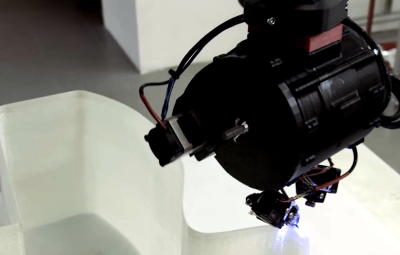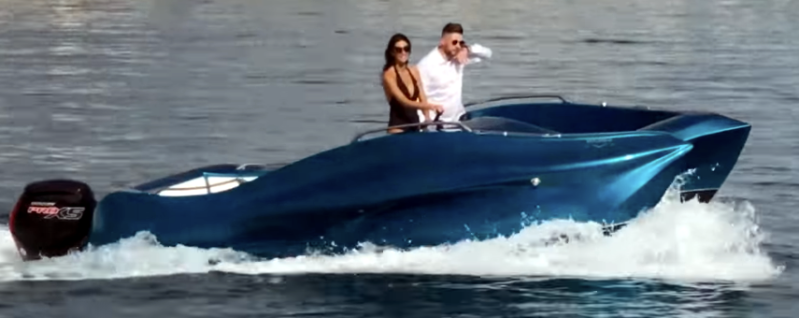It’s an age-old problem. You draw up a nice 6.5-meter long motorboat and then discover the shape won’t allow for a fiberglass mold. What do you do? If you’re [Moi], you grab a few Kuka robots and 3D print it using thermoplastic with embedded glass fibers. A UV light cures the plastic and you wind up with printed fiberglass. That’s the story behind the MAMBO, a 3D printed powerboat.
 Despite the color, the fiberglass isn’t blue out of the gate — the boat is painted. Still, it looks nice with lines inspired by [Sonny Levi]’s Arcidiavolo design from 1973. MAMBO stands for Motor Additive Manufacturing BOat. It has a dry weight of about 800 kg and is fitted with a cork floor, white leather seats, and an engine. We presume none of those things were 3D printed.
Despite the color, the fiberglass isn’t blue out of the gate — the boat is painted. Still, it looks nice with lines inspired by [Sonny Levi]’s Arcidiavolo design from 1973. MAMBO stands for Motor Additive Manufacturing BOat. It has a dry weight of about 800 kg and is fitted with a cork floor, white leather seats, and an engine. We presume none of those things were 3D printed.
Although it wasn’t fiberglass, we’ve seen a 3D printed boat before. In particular, the University of Maine’s giant 22,000 square foot printer cranked one out. We’ve also seen boats printed in standard PLA filament, which then had fiberglass cloth and resin applied after printing. True that one was only RC, but there’s no reason the concept couldn’t be scaled up if you had the patience.















Sorry, but that has to be the ugliest boat I’ve ever seen… The tech is interesting though.
Maybe he had a rich client that said “I want a botoxed boston whaler”
It looks like a fishing lure from the side.
Not very clear from the article, but I’m guessing they used the printed pieces as a base for doing actual fiberglass over. It says “Each individual section was laminated into a sandwich, each incorporating polyester resin and fiberglass, and then assembled with the others.”
Pretty good idea since I doubt you can get good enough layer adhesion if you just print and paint over it. Still a heck of a lot of work.
No. As far as I can tell they are really printing the material.
What they did was 3D print sections of the hull using a plastic coated fiberglass tow. They used vase-mode and built each section and finally joined all the sections together with fiberglass wrapped over the outside. They kind of cheated with the fiberglass wrap. It could have been built out of anything else, if they were planning to still wrap it. Also, the 3D printed layers are probably not the best direction for the kind of the stresses the boat will be under. The continuous fiberglass strand idea is cool but they could have used carbon fiber filled plastic. Really, anything would have sufficed. They apparently hit the plastic with UV laser light to cure it though, which is confusing. The only thing I can figure is it’s a UV resin, not actually plastic like they are calling it.
Indeed it really isn’t clear at all. If its a thermoplastic as they said why the UV light ‘cure’ a thermoplastic won’t need or want that…
It does sound like they are printing a fibreglass material initially. So perhaps its a FDM print which is then coated by the print head with a UV cure resin and glass fibres..
But as you say that lamination section suggests they might then be glassing the printed parts later, so its effectively just a 3d printed structure getting glassed.
Well, you do have to read a little bit since their web site is more glossy than technical. However, if you drill down:
CFM technology involves the use of robotic machines, capable of depositing continuous fibers impregnated with thermosetting resin in order to create products with optimized performance, starting from a three-dimensional model of the object. This allows the creation of fiber-reinforced products with mechanical characteristics comparable to those of unidirectional fiberglass, without the aid of models, molds and other tooling equipment. In this way it is possible to obtain not only prototypes, but real products in small lots or unique pieces, efficiently and cost-effectively.
Yes I read it, but it mentions a UV cure of thermo-plastic..
Which is almost a contradiction by nature – thermo-plastics you’d print like any FDM filament, I don’t know of anything that actually would want or even benefit from a UV bath, most of them would just be pushed to degrade faster… So just what are they printing in? Some clever new polymer blend that can be FDM style printed, then bathed in UV to trigger some sort of cross-linking. It’s plausible, but I’ve not seen any UV cure material yet that you can use as a thermoplastic at all.
It sounds like a fairly normal but large printing with the fibre reinforced FDM methods, then ‘laminating’ with more fibre glass, perhaps with a UV cure resin??? Which doesn’t make much sense, I’m sure there are some UV set resins that would work well as a fibre-glassing resin, but regular ol’ 2 part seems like a far better choice.
they mention thermo-set plastic, which is a plastic that is cured (via chemical reaction, in this case via UV light), compared to a thermoplastic that is cooled to solidify. See wikipedia: https://en.wikipedia.org/wiki/Thermosetting_polymer. Confusing names I know.
I guess they could be talking a relatively normal 2 part or UV cure resin – yeah its ‘thermo’ because we add heat via UV to make it polymerize…
As an owner of a 40 yr old sailboat, I have a deep appreciation for the quality of the hulls produced from molds, from that era.
This is an interesting proof of concept. A robotic chopgun? ;-) It’s not exactly clear how it was all put together, and why a “thermosetting” resin would require UV to cure. From the picture in the article, the printed hull had a pretty rough exterior, which would have required smoothing, filling, fairing and painting – all labour-intensive. Compare that with a boat made from a good mold, which is first sprayed with release compound, then gelcoat, then layers of resin-impregnated glass cloth and mat or roving, sometimes a core of foam or balsa, then more impregnated cloth etc. Yes, labour intensive, but the hull pops out smooth, shiny and already the right colour.
So I’m not yet convinced this will be a mainstream production method.
And yes… that’s one ugly boat.
I put some words in a search engine to have a look of how it was made.
After a few minutes I found a snippet in the middle of a video (about 10s) of printing a thin shell and then some guy in a white suit put some blankets of fiberglass on top of it and started rolling (with presumably epoxy).
And oh, It’s “patented” (apparently).
To me it just looks like some lame excuse for a few minutes of fame.
Link?
Patented by continuous composites AFAIK.
I know many have done similar for years…so there is prior art…but patented nonetheless.
The tech is interested but a but niche…and debatable if it is better than doing it by hand with forms.
(CC is local to me. I know the core people there)